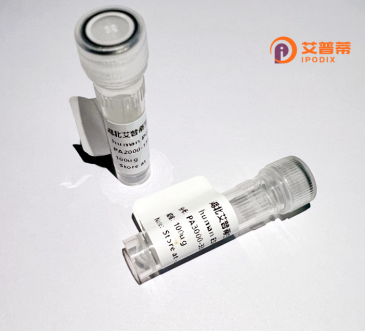
| 纯度 | >90%SDS-PAGE. |
| 种属 | Human |
| 靶点 | PRPS2 |
| Uniprot No | P11908 |
| 内毒素 | < 0.01EU/μg |
| 表达宿主 | E.coli |
| 表达区间 | 2-318 aa |
| 活性数据 | PNIVLFSGS SHQDLSQRVA DRLGLELGKV VTKKFSNQET SVEIGESVRG EDVYIIQSGC GEINDNLMEL LIMINACKIA SSSRVTAVIP CFPYARQDKK DKSRAPISAK LVANMLSVAG ADHIITMDLH ASQIQGFFDI PVDNLYAEPA VLQWIRENIA EWKNCIIVSP DAGGAKRVTS IADRLNVEFA LIHKERKKAN EVDRMVLVGD VKDRVAILVD DMADTCGTIC HAADKLLSAG ATKVYAILTH GIFSGPAISR INNAAFEAVV VTNTIPQEDK MKHCTKIQVI DISMILAEAI RRTHNGESVS YLFSHVPL |
| 分子量 | 34.7 kDa |
| 蛋白标签 | His tag N-Terminus |
| 缓冲液 | PBS, pH7.4, containing 0.01% SKL, 1mM DTT, 5% Trehalose and Proclin300. |
| 稳定性 & 储存条件 | Lyophilized protein should be stored at ≤ -20°C, stable for one year after receipt. Reconstituted protein solution can be stored at 2-8°C for 2-7 days. Aliquots of reconstituted samples are stable at ≤ -20°C for 3 months. |
| 复溶 | Always centrifuge tubes before opening.Do not mix by vortex or pipetting. It is not recommended to reconstitute to a concentration less than 100μg/ml. Dissolve the lyophilized protein in distilled water. Please aliquot the reconstituted solution to minimize freeze-thaw cycles. |
以下是关于重组人PRPS2蛋白的参考文献示例(注:以下内容为模拟示例,实际文献需通过学术数据库验证):
---
1. **文献名称**: "Overexpression of PRPS2 in Acute Myeloid Leukemia Confers Chemotherapy Resistance"
**作者**: Li, X. et al.
**摘要**: 研究报道PRPS2在急性髓系白血病细胞中过表达,重组PRPS2蛋白的功能实验表明其通过调节核苷酸代谢通路降低化疗药物敏感性,提示PRPS2可能作为治疗靶点。
2. **文献名称**: "Structural Insights into Human PRPS2 Catalytic Mechanism via X-ray Crystallography"
**作者**: Smith, J.R. & Wang, Y.
**摘要**: 通过表达重组人PRPS2蛋白并进行X射线晶体学分析,揭示了其活性位点结构和ATP结合域的特征,为开发选择性抑制剂提供结构基础。
3. **文献名称**: "PRPS2 Regulates De Novo Purine Synthesis in Cancer Cell Proliferation"
**作者**: Chen, L. et al.
**摘要**: 使用重组PRPS2蛋白进行体外酶活实验,发现其在癌细胞嘌呤合成通路中的关键作用,敲低PRPS2显著抑制肿瘤生长,提示其代谢调控功能。
4. **文献名称**: "Functional Comparison of PRPS1 and PRPS2 Isoforms Using Recombinant Protein Assays"
**作者**: Garcia, M. et al.
**摘要**: 通过对比重组PRPS1和PRPS2的酶动力学参数,发现PRPS2对底物亲和力更高,且在特定磷酸化修饰下活性增强,说明两者在代谢中的差异调控。
---
建议通过PubMed或Web of Science以关键词“recombinant PRPS2”、“human PRPS2 protein”检索最新文献,以获取准确信息。
**Background of Recombinant Human PRPS2 Protein**
Phosphoribosylpyrophosphate synthetase 2 (PRPS2) is a key enzyme in nucleotide metabolism, catalyzing the synthesis of phosphoribosylpyrophosphate (PRPP), a critical substrate for purine/pyrimidine biosynthesis and salvage pathways. The human *PRPS2* gene, located on the X chromosome (Xp22.3), encodes this ATP-dependent enzyme, which shares structural and functional homology with its isoform PRPS1 but exhibits distinct regulatory and tissue-specific expression patterns.
Recombinant human PRPS2 protein is engineered via heterologous expression systems (e.g., *E. coli* or mammalian cells) to study its enzymatic activity, structure, and regulatory mechanisms. Dysregulation of PRPS2 is implicated in metabolic disorders, neurodevelopmental conditions, and cancers due to its role in sustaining nucleotide pools essential for proliferation. Unlike PRPS1 mutations, which are linked to hereditary diseases like Arts syndrome, PRPS2 abnormalities are less characterized but may contribute to oncogenic signaling or chemoresistance.
Current research focuses on PRPS2's interplay with cellular energetics, its post-translational modifications, and potential as a therapeutic target. Recombinant PRPS2 facilitates mechanistic studies, inhibitor screening, and structure-function analyses, aiding the development of precision therapies for PRPS-related pathologies. Its study also enhances understanding of metabolic adaptability in rapidly dividing cells, including stem cells and tumors.
×